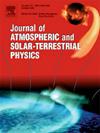强地磁暴期间Pc5脉动及其与太阳风参数的相关性研究
IF 1.9
4区 地球科学
Q3 GEOCHEMISTRY & GEOPHYSICS
Journal of Atmospheric and Solar-Terrestrial Physics
Pub Date : 2025-06-11
DOI:10.1016/j.jastp.2025.106534
引用次数: 0
摘要
本文研究了2014年2月19日和2015年6月22日至23日两个较长周期的强烈ULF活动期间的Pc5超低频率(ULF)波及其与太阳风参数和地磁指数的关系。本文采用连续小波变换(CWT)和互相关作为主要统计工具,对地面磁力计观测数据和OMNI数据集进行分析。结果表明:(1)行星际参数和地磁指数与Pc5脉动具有较强的相关性;(2)显著Pc5功率主要集中在6 ~ 9 min周期内。这表明,低纬度地磁波动不是局部产生的,而是反映了起源于磁层和高纬度电离层的全球地磁变化,这与以前的发现一致。虽然行星际磁场(IMF) Bz的南向分量通常被认为是地磁风暴的主要驱动因素,但我们发现它对Pc5脉动的影响很小。相反,我们的分析表明,地面的Pc5功率与太阳风速度有关,证实了太阳风动力学在调制Pc5波活动中的作用。这些发现增强了我们对Pc5波激发机制及其对地磁风暴期间太阳风条件的依赖性的理解。本文章由计算机程序翻译,如有差异,请以英文原文为准。
Investigation of Pc5 pulsations and their correlation with solar wind parameters during intense geomagnetic storms
This study examines Pc5 ultra-low frequency (ULF) waves and their relationship with solar wind parameters and geomagnetic indices during two extended periods of intense ULF activity on 19 February 2014 and 22–23 June 2015. We analyze observations from ground-based magnetometers and the Operating Missions as Nodes on the Internet (OMNI) dataset, employing continuous wavelet transform (CWT) and cross-correlation as primary statistical tools. Our results reveal that: (1) interplanetary parameters and geomagnetic indices exhibit strong correlations with Pc5 pulsations; (2) the majority of significant Pc5 power is concentrated within the 6–9 min period band. This suggests that low-latitude geomagnetic fluctuations are not locally generated but rather reflect global geomagnetic field variations originating in the magnetosphere and high-latitude ionosphere, consistent with previous findings. While the southward component of the Interplanetary Magnetic Field (IMF) is often considered the primary driver of geomagnetic storms, we find its influence on Pc5 pulsations to be minimal. Instead, our analysis shows that ground-based Pc5 power scales with solar wind speed, corroborating the role of solar wind dynamics in modulating Pc5 wave activity. These findings enhance our understanding of Pc5 wave excitation mechanisms and their dependence on solar wind conditions during geomagnetic storms.
求助全文
通过发布文献求助,成功后即可免费获取论文全文。
去求助
来源期刊

Journal of Atmospheric and Solar-Terrestrial Physics
地学-地球化学与地球物理
CiteScore
4.10
自引率
5.30%
发文量
95
审稿时长
6 months
期刊介绍:
The Journal of Atmospheric and Solar-Terrestrial Physics (JASTP) is an international journal concerned with the inter-disciplinary science of the Earth''s atmospheric and space environment, especially the highly varied and highly variable physical phenomena that occur in this natural laboratory and the processes that couple them.
The journal covers the physical processes operating in the troposphere, stratosphere, mesosphere, thermosphere, ionosphere, magnetosphere, the Sun, interplanetary medium, and heliosphere. Phenomena occurring in other "spheres", solar influences on climate, and supporting laboratory measurements are also considered. The journal deals especially with the coupling between the different regions.
Solar flares, coronal mass ejections, and other energetic events on the Sun create interesting and important perturbations in the near-Earth space environment. The physics of such "space weather" is central to the Journal of Atmospheric and Solar-Terrestrial Physics and the journal welcomes papers that lead in the direction of a predictive understanding of the coupled system. Regarding the upper atmosphere, the subjects of aeronomy, geomagnetism and geoelectricity, auroral phenomena, radio wave propagation, and plasma instabilities, are examples within the broad field of solar-terrestrial physics which emphasise the energy exchange between the solar wind, the magnetospheric and ionospheric plasmas, and the neutral gas. In the lower atmosphere, topics covered range from mesoscale to global scale dynamics, to atmospheric electricity, lightning and its effects, and to anthropogenic changes.
 求助内容:
求助内容: 应助结果提醒方式:
应助结果提醒方式:


